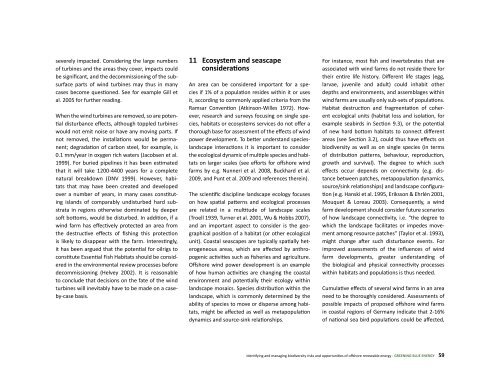Greening Blue Energy - BioTools For Business
Greening Blue Energy - BioTools For Business
Greening Blue Energy - BioTools For Business
Create successful ePaper yourself
Turn your PDF publications into a flip-book with our unique Google optimized e-Paper software.
severely impacted. Considering the large numbers<br />
of turbines and the areas they cover, impacts could<br />
be significant, and the decommissioning of the subsurface<br />
parts of wind turbines may thus in many<br />
cases become questioned. See for example Gill et<br />
al. 2005 for further reading.<br />
When the wind turbines are removed, so are potential<br />
disturbance effects, although toppled turbines<br />
would not emit noise or have any moving parts. If<br />
not removed, the installations would be permanent;<br />
degradation of carbon steel, for example, is<br />
0.1 mm/year in oxygen rich waters (Jacobsen et al.<br />
1999). <strong>For</strong> buried pipelines it has been estimated<br />
that it will take 1200-4400 years for a complete<br />
natural breakdown (DNV 1999). However, habitats<br />
that may have been created and developed<br />
over a number of years, in many cases constituting<br />
islands of comparably undisturbed hard substrata<br />
in regions otherwise dominated by deeper<br />
soft bottoms, would be disturbed. In addition, if a<br />
wind farm has effectively protected an area from<br />
the destructive effects of fishing this protection<br />
is likely to disappear with the farm. Interestingly,<br />
it has been argued that the potential for oilrigs to<br />
constitute Essential Fish Habitats should be considered<br />
in the environmental review processes before<br />
decommissioning (Helvey 2002). It is reasonable<br />
to conclude that decisions on the fate of the wind<br />
turbines will inevitably have to be made on a caseby-case<br />
basis.<br />
11 Ecosystem and seascape<br />
considerations<br />
An area can be considered important for a species<br />
if 1% of a population resides within it or uses<br />
it, according to commonly applied criteria from the<br />
Ramsar Convention (Atkinson-Willes 1972). However,<br />
research and surveys focusing on single species,<br />
habitats or ecosystems services do not offer a<br />
thorough base for assessment of the effects of wind<br />
power development. To better understand specieslandscape<br />
interactions it is important to consider<br />
the ecological dynamic of multiple species and habitats<br />
on larger scales (see efforts for offshore wind<br />
farms by e.g. Nunneri et al. 2008, Buckhard et al.<br />
2009, and Punt et al. 2009 and references therein).<br />
The scientific discipline landscape ecology focuses<br />
on how spatial patterns and ecological processes<br />
are related in a multitude of landscape scales<br />
(Troell 1939, Turner et al. 2001, Wu & Hobbs 2007),<br />
and an important aspect to consider is the geographical<br />
position of a habitat (or other ecological<br />
unit). Coastal seascapes are typically spatially heterogeneous<br />
areas, which are affected by anthropogenic<br />
activities such as fisheries and agriculture.<br />
Offshore wind power development is an example<br />
of how human activities are changing the coastal<br />
environment and potentially their ecology within<br />
landscape mosaics. Species distribution within the<br />
landscape, which is commonly determined by the<br />
ability of species to move or disperse among habitats,<br />
might be affected as well as metapopulation<br />
dynamics and source-sink relationships.<br />
<strong>For</strong> instance, most fish and invertebrates that are<br />
associated with wind farms do not reside there for<br />
their entire life history. Different life stages (egg,<br />
larvae, juvenile and adult) could inhabit other<br />
depths and environments, and assemblages within<br />
wind farms are usually only sub-sets of populations.<br />
Habitat destruction and fragmentation of coherent<br />
ecological units (habitat loss and isolation, for<br />
example seabirds in Section 9.3), or the potential<br />
of new hard bottom habitats to connect different<br />
areas (see Section 3.2), could thus have effects on<br />
biodiversity as well as on single species (in terms<br />
of distribution patterns, behaviour, reproduction,<br />
growth and survival). The degree to which such<br />
effects occur depends on connectivity (e.g. distance<br />
between patches, metapopulation dynamics,<br />
source/sink relationships) and landscape configuration<br />
(e.g. Hanski et al. 1995, Eriksson & Ehrlén 2001,<br />
Mouquet & Loreau 2003). Consequently, a wind<br />
farm development should consider future scenarios<br />
of how landscape connectivity, i.e. “the degree to<br />
which the landscape facilitates or impedes movement<br />
among resource patches” (Taylor et al. 1993),<br />
might change after such disturbance events. <strong>For</strong><br />
improved assessments of the influences of wind<br />
farm developments, greater understanding of<br />
the biological and physical connectivity processes<br />
within habitats and populations is thus needed.<br />
Cumulative effects of several wind farms in an area<br />
need to be thoroughly considered. Assessments of<br />
possible impacts of proposed offshore wind farms<br />
in coastal regions of Germany indicate that 2-16%<br />
of national sea bird populations could be affected,<br />
Identifying and managing biodiversity risks and opportunities of offshore renewable energy - GREENING BLUE ENERGY 59



